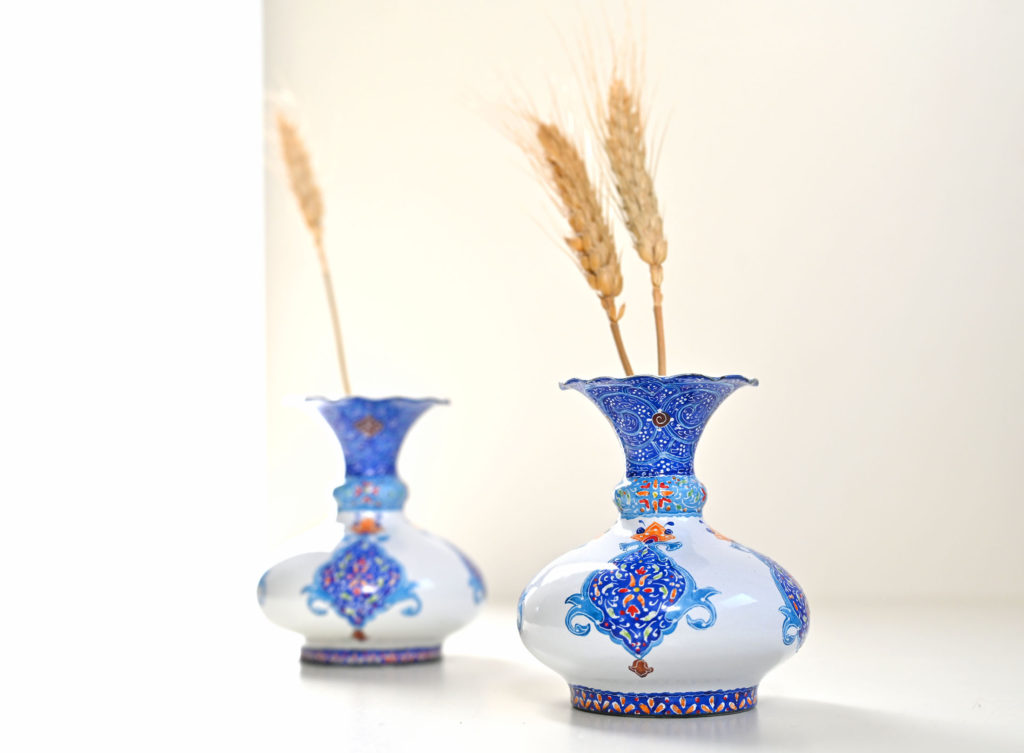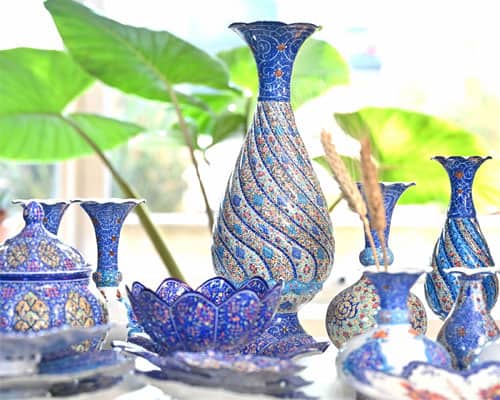
What Is Minakari? Minakari, a Persian word that means coloured or inlaid, is the art of applying coloured enamel to metalwork or pottery. The enamel may be applied to flat areas, or as an inlay into cut designs. This technique is used in jewellery and tile work, and on miniatures and large objects alike.

What is minakari?
Minakari is a traditional Iranian art form that involves the fusion of glazed and hand-painted designs on copper and metal objects. Inspired by natural elements, minakari paintings are created using various colours, shapes and lines. These designs are then glazed over to seal them in place, providing a unique visual contrast between the colourful designs and the copper plate’s metallic sheen.
With so many beautiful minakari objects available for both home decor and commercial display, you’re sure to find something that suits your needs! Whether you’re looking for a plate to use at your next dinner party or a vase for your living room, we’ve got what you need.

History of minakari
Minakari is a traditional art form in Iran, which has been practised for centuries. This technique uses intricate geometric designs to create beautiful patterns on pottery and textiles. The word minakari means painted or painted in Farsi (or the Iranian language). Esfehan is the city where this technique originated and it remains an important centre for the craft. Best quality minakari are usually made from enamel colours on copper but can also be found on porcelain and metal.

Modern-day minakari
When you think about Iran, you might think about the Iranian Women – Life – Freedom (زن-رندگی-آزادی) Revolution and trending #MahsaAmini (#مهسا_امینی) on Twitter. While these are essential aspects of Iranian history, it’s also home to an amazing art form called minakari. Minakari is a traditional technique that originated in Isfahan and involved painting with an enamel and metal oxide powder on glazed pottery. Today, this technique is used on many household items such as plates, boxes, vases and more. Colours can be mixed using natural dyes and minerals for different effects. The surface is first covered with several layers of clear glaze and then painted with a design before being fired at low temperature in an open fire kiln. As time passes by, the colours will fade over time but this only adds to its beauty. You’ll find that pieces from earlier periods are more vibrant while pieces from later periods have more muted colours.

How to use minakari?
Minakari is a traditional Iranian art that has been practised for centuries. This technique originated in the Safavid Era and was originally used to decorate ceramics. However, over time, it has evolved into a form of decoration on many different household items including pottery, carpets, textiles and more. It’s believed that this technique came about because there were no other colours available in Iran during this time period. The name minakari comes from the word Naqsh, meaning design or drawing. One of the most common ways to do minakari is by using a resist paste made from rice flour and water that is then applied to paper or cloth before applying colour on top with water-based dyes or enamel paints.

Where can you find amazing pieces made with the Minakari technique?
One place you can find a stunning example of minakari artwork is on our Glazed Hand Painting and Enamel Copper products. The intricate floral motifs on these pieces, made by talented artisans in India, demonstrate the skill and patience that go into making a piece with this technique.
If you want to explore the world of minakari more, there are plenty of resources available online. For instance, check out this blog post about what minakari is or explore another beautiful set of minakari products on our site.
